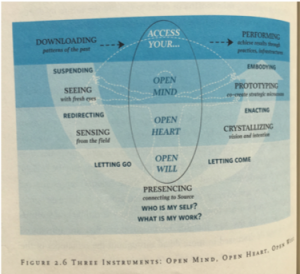U Theory
Theory U: Leading from the Future as it Emerges: The Social Technology of Prescencing (2007). C. Otto Scharmer
Reasons to Read: I love how Scharmer, researcher at MIT, writes for a corporate executive audience, engaged in increasing leadership capacity. This atypical leadership management book utilizes language of unity, love and transcendence. Scharmer blends modalities of heart, head, and hands (i.e., open mind, openheart, and open will) to exonerate the pathway of leadership success. This book is about moving from an “I” or “me” to a merging to an “us” way of being. When we start to shift our paradigm: shift our reality to see what was previously unseen and see how our own part in maintaining the old and inhibiting or denying the new, the dam starts to break.

page 227- 229
Quotes:
- “At the outset of this investigation, I argued that leaders and people at all levels in all systems are increasingly presented with disruptive challenges and changes that require them to let go of old patterns of thinking and behaviour and to sense new future possibilities. These challenges may be techno-economic, relational-political or cultural-spiritual—or all three. Together we share a universal and deeply felt need to expressed in the question: how do we confront these challenges and cross human developmental threshold? Doing so will require a new quality of awareness and attention: attention not only to what we do and how we do it but to the inner source from which we operate- which for most of us is a blind spot”
Four different sources: 1. From the centre (I-in-me), from the periphery (I-in-it), from beyond one’s periphery (I-in-you), and from permeating all of one’s open boundaries (I-in-now). And depending on what source we operate from, our actions will effect vastly different outcomes and results” (p227-228)
Two key parts to the U Theory
- Sensing: When moving from seeing to sensing, perception beings to happen from the whole field. Peter Senge believes that this is at the heart of systems thinking. It is about closing the feedback loop between people’s experience of reality (“what the system is doing to us”) and their sense of participation in the whole cycle of experience. (p. 143)
- Presencing: One of the key stepping stones of the U Theory is called Presencing, which “is a movement where we approach our self from the emerging future” (p.163) He goes on to say, “presencing resembles sensing. Both involve shifting the place of perception from the interior to the exterior of one’s physical organization. Here we must move to our source: “who is my self? And “what is my work”? (p.164). This can only be done with an open heart, open mind and open will.
The U Theory challenges the notion that old systems have been blind to externalities and that new ways of being are possible by integrating the U Theory to outdated models.
Questions:
Presencing in the social field can look many different ways. Scharmer says, “in presencing, group members enter-often enabled through a crack or a moment of silence in which the group beings to let go of “the script”- a deeper space of presence and connection to one another. They then move into a generative flow of co-creating and bring forth something profoundly new.” (p 237).
How do you know whether or not you have been in such a place?
What has things, activities and events have shifted the consciousness of a group? How do we get there?